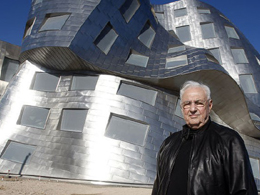COLUMNS
LEVELLING

15 November, 2010
The fever of the naked emperor
Brain health and architecture.
A key attribute of creativity is the capacity to transcend stereotypes. Are there any limits to that? The question re-emerged in my mind seeing the new work by Frank Gehry in Las Vegas, the Cleveland Clinic of Lou Ruvo Center for Brain Health. In this case, I feel that the familiar eccentricity went too far.
I have never been a fan of the architecture by the famous Canadian architect, who at the age of 50 triggered the deconstructionist fashion starting from his own house, coincidentally at the same time with the spread of Punk. I dare say that I find it blatantly pompous, outrageously wasteful, and unnecessarily complex -the exact opposite of my own values. The strong sculptural qualities do not negate the fact that they are functional rather than monumental structures, which -like all buildings- are built to serve human beings rather than a few egos. Undeniably, something worthy of admiration is the architectural and construction staff that translates the rampant ideas of the maitre to a manufacturable reality. But personally I wonder how such an expensive architecture satire has become a smashing hit and a paradigm that many strive to emulate.


(Left photo)Cleveland Clinic in Las Vegas, 2010 (architect Frank Gerry). Cost ~12,000 €/m2 (Right photo)Center of Visual Arts in Edmonton Alberta Canada, 2010 (architect Randall Stout,, a former Gehry Partners LLP associate). Cost ~11,000 €/m2.
Surely any architectural work reflects the sponsors for its implementation; at the same time, it embodies social values, philosophical ideas, and technical capabilities of its era. The whimsical design of deconstructed buildings pays little attention to construction, economic, and environmental imperatives, thus ensuring that they do not pass unnoticed. In that respect, they satisfy a centuries old architectural requirement, the exaltation of individuals or groups through the architectural image. Of course that comes at a price: for example, the building cost of the Las Vegas clinic reached almost 12,000 €/m2.
The emancipation from stereotypes is a significant achievement. But when it becomes a repeated stereotype itself, then something is fishy. I wonder if the self-serving goals of originality and glamour, the shanty approach in design, the absence of social content, and the contempt for material reality can establish an acceptable architectural concept, having as drab excuse the manifestation of philosophical theories like Derrida's.
It is better to leave others, more knowledgeable than me, to analyse the details about the origins and incentives of the deconstruction constellation. However, the aura of decay and decadent luxury emanating from the forms and materials of such constructions probably epitomizes our time more accurately than any other architectural expression today. In that sense, there is a remarkable visual resemblance between Gehry's works and the ruins of World Trade Center or bombarded Baghdad.

Cleveland Clinic in Las Vegas during construction, 2010 (architect Frank Gerry)


(Left photo)Building 7 at NY World Trade Center after its brutal deconstruction, 2001 (architect Osama Bin Laden) (Right photo) Deconstructed building in Baghdad, 2003 (architect unknown)
Certainly there are more aspects of our era, some of which facilitate the realization of such projects: it is the information technology with the capabilities provided by CAD/CAM/CAE, as well as modern construction tools and materials. Without them it would be very difficult to transform the deconstructed inspiration into real buildings of chaotic geometry.
Nevertheless, can deformed surfaces develop into building spaces? Apparently not, if we notice the fact that they are often supplemented by more regular structures, recruited to meet operational needs. For example, the recent Gehry project blends two completely different geometries, a deconstructed one on the south side and a cubist one on the north. It is not the first time: another example is the Hotel Marqués de Riscal in the Basque town of Elciego (built 2006), where metallic ribbons cover conventional blocks.

Cleveland Clinic in Las Vegas (south & north side)

Hotel Marqués de Riscal in the Basque town of Elciego, 2006 (architect Frank Gerry)
The rudimentary difference between the two sides of Lou Ruvo Center for Brain Health suggests two contradictory hemispheres of the brain. That probably reflects the schizophrenia of our time, in which contradiction and absurdity are promoted to healthy perception -for example, the idea that deformity is beautiful, that consumerism can be green, that the global problem of poverty and hunger can be addressed by noisy symposia of the jet-set, or the oxymoron that we hear more and more strongly that it would be beneficial for hoi polloi to bestow their common property into the hands of a few.
O tempora, o mores ...
Thanos N. Stasinopoulos
Dr. Architect Engineer NTUA, AAGradDipl.
9.11.2010
Related articles:
- Pills or diet? ( 31 August, 2011 )
- After the bubble gums ( 12 September, 2010 )
- Thanos Stasinopoulos .PIRAEUS TOWER 2010 ( 08 October, 2010 )
- Barriers, barriers everywhere ( 14 December, 2010 )
- Scenarios for the future ( 10 January, 2011 )
- Parks and submarines ( 21 February, 2011 )
- The oil barrel project ( 28 April, 2011 )
- “We are animals” ( 02 June, 2011 )
- On Winds and Waters ( 11 July, 2011 )
- The Titanic ( 07 October, 2012 )










